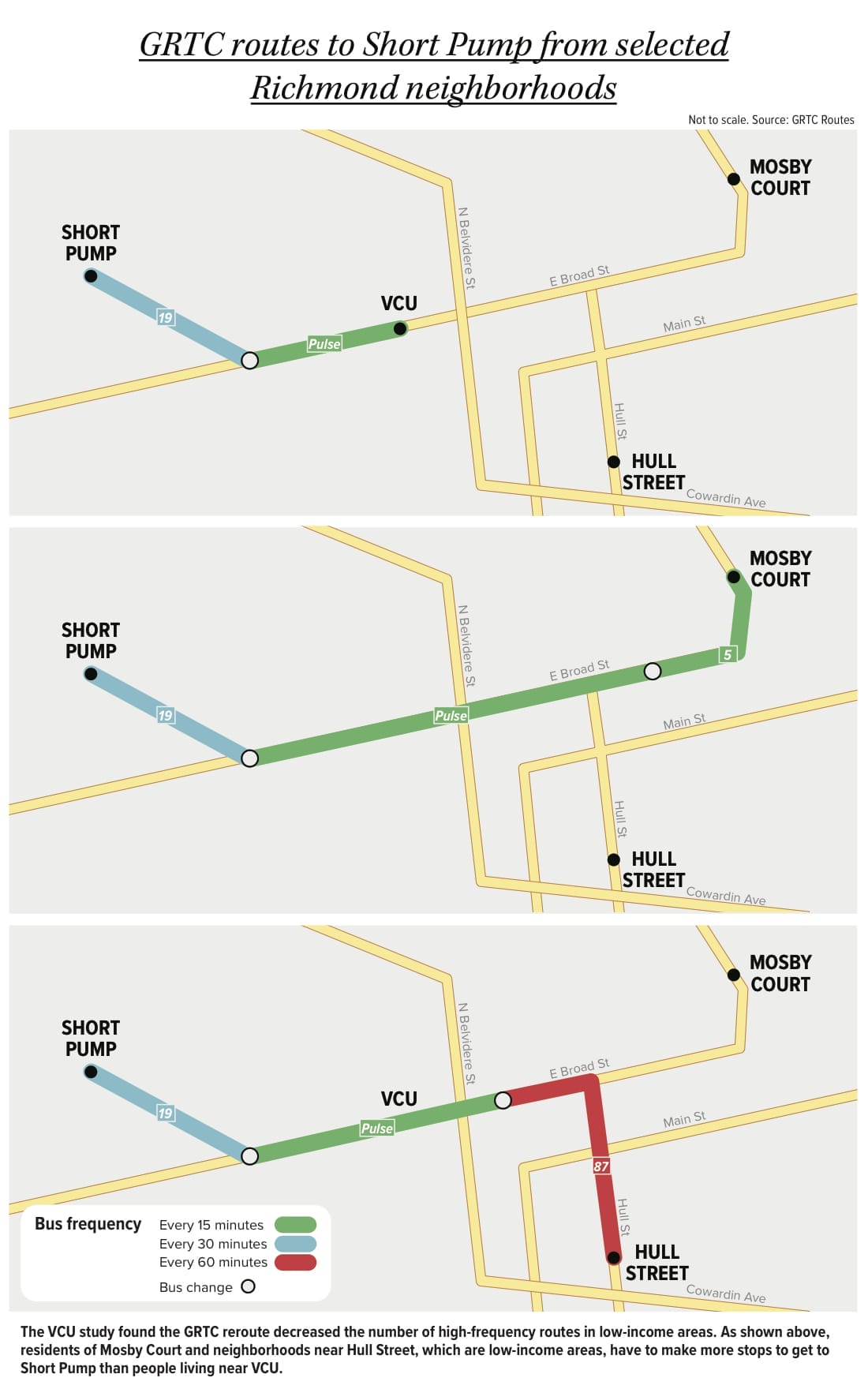GRTC reroute disadvantages lower-income areas, study shows

Infographic by Mai-Phuong Bui
Hannah Eason, Contributing Writer
The Greater Richmond Transit Co. reroute inadequately serves Richmond’s low-income neighborhoods, according to a recent study from VCU’s Center for Urban and Regional Analysis.
Low-income neighborhoods are largely limited to low-connectivity routes, the study found. Low connectivity means a rider may have to change buses several times to reach their destination. The comparison between old and new routes found a 22 percent decrease in residents within a quarter mile of a transit stop. The study also observed job accessibility through GRTC, which improved by six percent.
“While GRTC has taken a forward-thinking approach to improving job accessibility, there is still room for improvement related to improving transit access to affordable housing,” said Sarin Adhikari, research economist at CURA and member of the study.
The issue of low connectivity is partly due to GRTC giving more attention to “frequency over proximity,” said Fabrizio Fasulo, CURA director and study member. Fasulo and Adhikari said low-income areas are often less populated, and therefore have fewer GRTC riders.
“Whoever lives [in low-income areas] needs public transit much more than other people,” said Adhikari, “Others have options. They don’t have options.”
Adhikari suggested extending routes to low-income areas, “even if [GRTC] is losing money.”
Neighborhoods in the East End such as Mosby, Whitcomb, Brauers, Peter Paul and Fulton have the lowest connectivity to public transit services. Southside neighborhoods near Jefferson Davis Highway, Hull Street and Midlothian Turnpike have equally low connectivity.



Sarah Pentecoste, VCU alumna and frequent GRTC Pulse rider, said she was frustrated with the GRTC’s low frequency in the Fulton area.
“That area is already unserved, and those riders have to walk several blocks to get to a bus stop already. And now it’s not even coming as frequently,” Pentecoste said. “It makes that trip a lot harder for people who live in that neighborhood.”
Aaron Simmonds, a GRTC rider who grew up in Southside and Henrico, said he didn’t ride GRTC until moving to downtown Richmond.
“It’s kind of messed up how they don’t really have access further out,” Simmonds said. “It’s easy for me [downtown], who doesn’t really need it, compared to other people who do.”
Out of more than 32,000 residential units within a quarter mile of a transit stop, only 48 percent of those bus stops have fair to high connectivity. Almost half of lower-income residents do not have access to high-connectivity GRTC routes. Routes with higher connectivity are not only faster, but lessen the risk of
Nearly 20 percent of residential units were within a quarter mile from a transit stop. More than half of residential units were over three-quarters of a mile from a transit stop.
While there is a lack of coverage in residential areas, the reroutes have improved access to job centers, particularly Short Pump and west Henrico. The study showed additional access to 11,400 jobs within a quarter mile, an estimated six percent increase. 24,600 jobs are located within a half-mile of transit stops, proving an 11 percent increase.
The connection between housing and job centers showed a “huge improvement,” Fasulo said. In a statement, Fasulo said the city is responsible for ensuring that “the whole community” benefits from economic expansion.
“This is especially important for the marginalized and disadvantaged communities in the region that have felt, and rightfully so, left behind in past developments,” Fasulo said.
The study primarily focused on individuals living below the poverty level, individuals of color, those with limited English proficiency and those who are dependent on public transportation. Public transportation access for this population could provide a “big picture look” at the equal access in the region, according to the study.
Fasulo and Adhikari said these observations are part of a larger study, which will later take into account renters, homeowners and those dependent on public transportation.
“The Great Richmond Reroute” is the first major update since downtown’s electric trolleys came to a halt in 1949, according to the GRTC website. This update came at the same time as The Pulse, the city’s first bus rapid transit system. GRTC has been jointly owned by the City of Richmond and Chesterfield County since it was purchased from private owners in 1973. GRTC did not respond to requests for comment.


